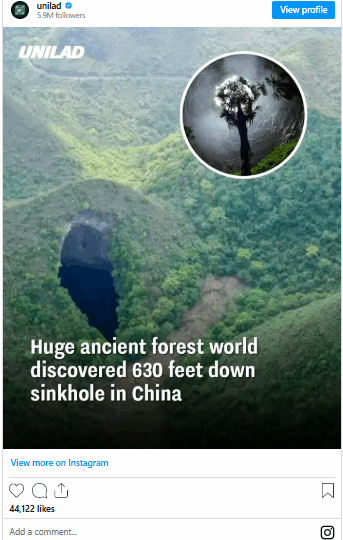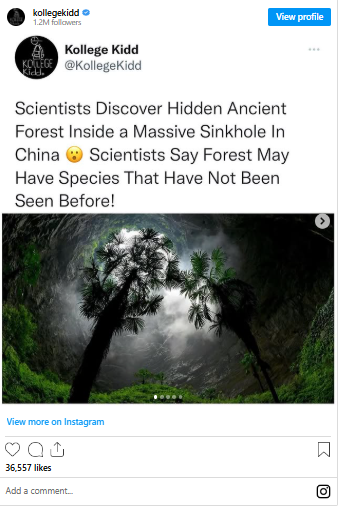Deep within the Leye-Fengshan Global Geopark in China, an extraordinary natural phenomenon has been discovered: a massive sinkhole located approximately 630 feet (about 192 meters) below the Earth’s surface.
This incredible geological feature harbors an ancient, lush forest unlike anything found above ground.
The discovery has captivated scientists and nature enthusiasts alike, offering a rare glimpse into a hidden ecosystem that has remained isolated for centuries.
The Leye-Fengshan Global Geopark is situated in China’s Guangxi Zhuang Autonomous Region, a place renowned for its unique karst landscapes.
These landscapes are characterized by soluble rocks such as limestone that have been shaped over millions of years by water erosion, resulting in caves, underground rivers, sinkholes (known locally as “tiankengs”), and the world’s longest natural bridge.
UNESCO recognizes this geopark for its remarkable geological features and biodiversity, describing it as a vast area dominated by sedimentary rocks formed during the Devonian to Permian periods, which span over 300 million years ago.
UNESCO’s official description highlights the complex geological structure of the geopark, which includes an ‘S’-shaped formation and a rhombus pattern that influence the flow of two major subterranean rivers, the Bailang and Poyue. These rivers, along with the Buliuhe River formed between them, have carved out numerous karst formations throughout the area. Visitors and researchers alike can witness striking high karst peak clusters known as “fengcong,” large flat-floored depressions called “poljes,” sparkling karst springs, natural “windows” into the underground called tiankengs, and extensive cave systems filled with impressive speleothems (stalactites and stalagmites). In addition to its geological wonders, the park contains important fossil sites, including those of the giant panda, along with significant stratigraphic sections from the Neogene period.

Karst terrain forms when slightly acidic water, often rainwater mixed with carbon dioxide, slowly dissolves soluble rocks like limestone. This process creates underground voids and tunnels over time. When these underground cavities grow too large to support the weight above, the surface collapses, creating dramatic sinkholes.
In May 2022, a team of scientists conducting research within the Leye-Fengshan Global Geopark made a remarkable discovery—a previously unknown sinkhole that measures more than 1,000 feet (approximately 305 meters) in length, 490 feet (about 150 meters) in width, and nearly 630 feet deep. This enormous pit not only astonished the scientific community due to its size but also because of the ancient forest flourishing within its walls. The sinkhole is home to many tall, mature trees—some reaching heights of over 130 feet (about 40 meters)—alongside diverse plant species. There is a strong possibility that some of these species have never been documented by science before, presenting exciting opportunities for biological discovery.
Within the vast sinkhole, researchers have identified three separate cave openings that lead deeper into the underground system. Chen Lixin, the leader of the expedition, expressed enthusiasm about the potential for finding new species and studying unique ecosystems preserved within these caves. He noted the remarkable size and maturity of the vegetation thriving in the sinkhole’s isolated environment.

George Veni, director of the National Cave and Karst Research Institute, provided further insight into the geological context of this discovery. He explained that karst landscapes vary widely around the world depending on factors such as climate, temperature, and geological history. In some regions, karst features might be subtle and difficult to detect, with small sinkholes or cave entrances barely noticeable to the naked eye. In contrast, southern China is known for its spectacular karst topography, including massive sinkholes and cavernous cave openings that reveal dramatic subterranean worlds.
Veni emphasized that the continuous process of acidic rainwater dissolving the bedrock is fundamental to the formation of such karst features. As rainwater absorbs carbon dioxide from the atmosphere and soil, it becomes slightly acidic and begins to erode cracks in the limestone. Over thousands or millions of years, this erosion enlarges these cracks into caves and underground rivers. When the support below weakens sufficiently, the land above collapses, forming the large sinkholes or “tiankengs” that are so distinctive in this region.
This newly discovered sinkhole is notable as the 30th known tiankeng in the Leye-Fengshan Global Geopark area—a testament to the region’s exceptional karst landscape. The park is also home to the Xiaozhai Tiankeng, the world’s largest sinkhole, further underscoring China’s global importance in the study of karst phenomena.
The discovery not only highlights the geological marvels hidden beneath the Earth’s surface but also underscores the ecological significance of these subterranean habitats. The isolated forest within the sinkhole serves as a living museum, preserving ancient plant life and possibly undiscovered species in an environment untouched by modern human activity. Scientists anticipate that continued exploration and research in the Leye-Fengshan Geopark will yield valuable insights into biodiversity, geology, and the evolutionary history of life on Earth.
For those fascinated by natural wonders and the mysteries hidden beneath our feet, the “Heavenly Pits” of China offer an extraordinary window into a world where nature’s forces have shaped breathtaking landscapes and ecosystems over millions of years.





